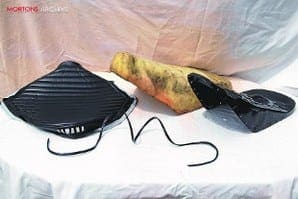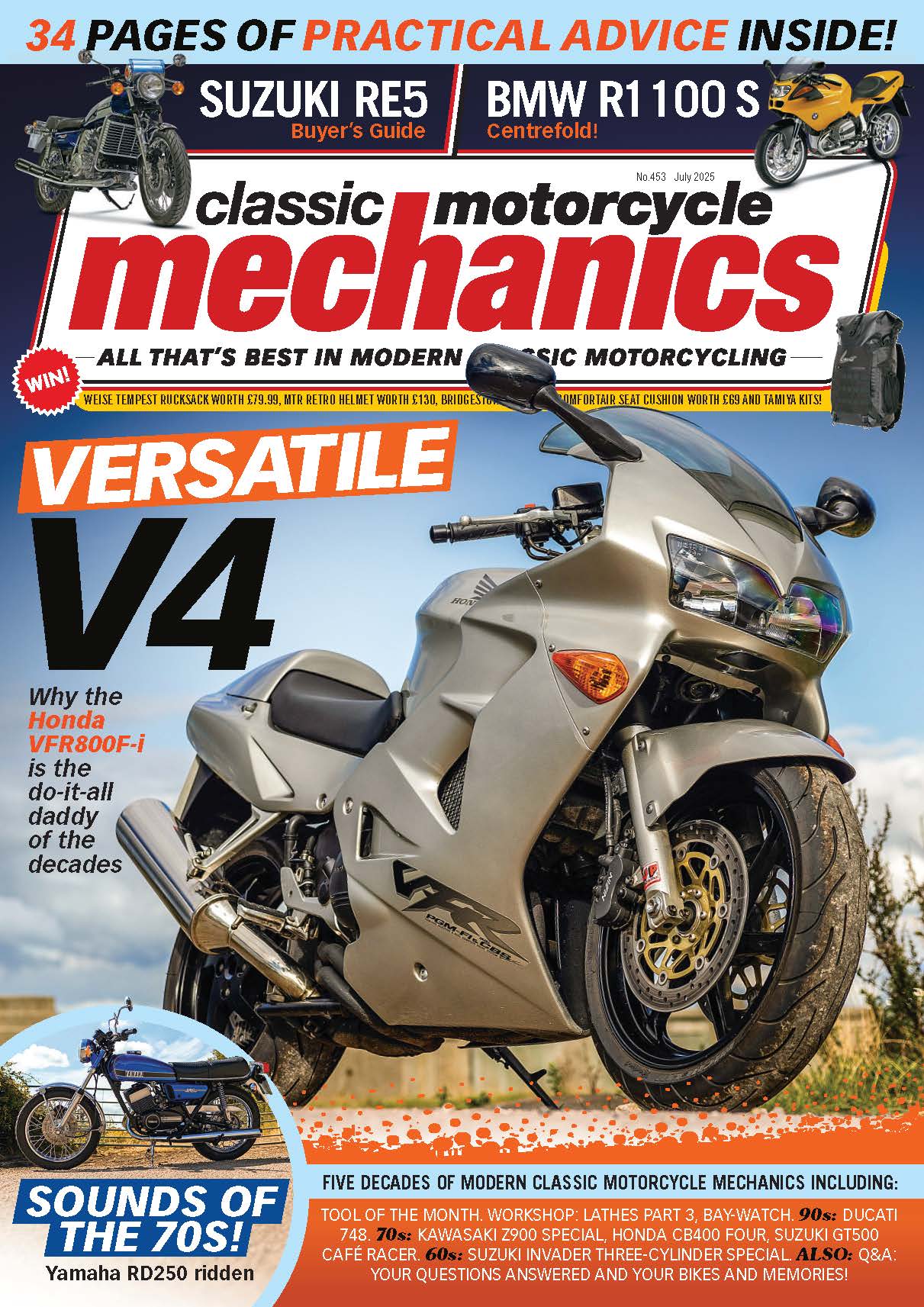
At some point when owning an old bike or during a restoration it’s likely that the seat will need re-covering. There are several well known companies that offer an excellent service and I’ve used at least a couple for my various projects. However, I like to do as much as possible on my projects. I’ve done a few seat repairs and renovations and one complete refurbishment from scratch with a new cover before, so here goes number two.
Undoubtedly the best way to start off is with a genuine seat cover and surprisingly quite a few are still listed by manufacturers available at shows, via eBay etc. An aftermarket copy may be fine but if you can get a replica made to the original pattern it’s probably a better bet. If the seat pan is rusted through or cracked it’ll need to be repaired either by welding or glass fibre. Also make sure the seat foam is viable or you will never achieve a decent job.
So here we go with the all important edging strip, a new cover, seat pan and foam (picture 1).
Rule number one is ensure everything is warm; try fitting a cover in a cold garage and it’ll be hard work and probably turn out wrong. Either a nice warm room or outside in the sun makes the job so much easier. Working off a soft surface the edge trim is fixed to the seat base and the foam checked for fit (picture 2).
 If the edge trim is damaged or unavailable I add a double thickness of duct tape to the edge of the pan to stop the cover tearing when it’s hooked down in place. The single biggest issue I’ve found replacing covers is getting them to move fractionally when I need to adjust the position a gnat’s what-not. The crafty dodge here is to add a layer of thin crinkly polythene twixt cover and seat foam; this allows one to slide over the other. Serendipitously the bag the seat cover came in is ideal and fits a treat (picture 3).
If the edge trim is damaged or unavailable I add a double thickness of duct tape to the edge of the pan to stop the cover tearing when it’s hooked down in place. The single biggest issue I’ve found replacing covers is getting them to move fractionally when I need to adjust the position a gnat’s what-not. The crafty dodge here is to add a layer of thin crinkly polythene twixt cover and seat foam; this allows one to slide over the other. Serendipitously the bag the seat cover came in is ideal and fits a treat (picture 3).
Getting the cover correctly in position is pivotal to the final appearance and the key lies in getting the front and back of the cover spot on. Using a rule, tape measure and a keen eye the front is manoeuvred into place and held with some '10 for a quid' pincer cramps out of the local supermarket; their rubber faces ensure the cover isn’t marked (picture 4). Applying the same MO to the rear of the cover and ensuring the all important lettering is central and horizontal I can apply more clamps to the edges making sure nothing is creased (picture 5).
 Before taking the old cover off it’s really worthwhile making a few measurements as to the depth of the side skirt relative to the edge piping or welded seams; this will give a good indication of how tight or loose to pull the new seat cover. To assist transferring this dimension over to the new cover correctly I use either a piece of masking tape or make a removable mark with dress maker’s chalk.
Before taking the old cover off it’s really worthwhile making a few measurements as to the depth of the side skirt relative to the edge piping or welded seams; this will give a good indication of how tight or loose to pull the new seat cover. To assist transferring this dimension over to the new cover correctly I use either a piece of masking tape or make a removable mark with dress maker’s chalk.
Assuming everything is in place and the back and front appear as I want them to I can now start hooking the cover in place over the pressed tangs or dragons teeth. The majority of seat covers are based on a strong woven base material and it’s the integral strength of the fabric’s weave that holds everything in place. The tangs can be a bit fragile over time so I make every effort to only move them if have to. I’ve found that, if after removing the old cover, I leave the tangs pointing toward the underside of the seat base at an angle of 60-70 degrees I can loosely secure the cover in place but remove or adjust it if necessary. Here I’ve hooked a portion of the cover by just piercing the under skirt by a few millimetres (picture 6).
 Working on the front and back first I secure the critical ends of the cover in place then alternate working back and forth across the sides gradually fixing the entire cover in place but still only just hooking it down by the all important few millimetres. This way I can easily adjust or reposition if necessary and know the cover is being unnecessarily weakened. I take measurements and compare them to my readings taken from the old seat cover. Now is the point where I can make any changes if necessary. Occasionally one or more of the tangs is either missing or falls off due to rusting or metal fatigue (picture 7). In a situation like this I trim away any residual crinkly plastic and wipe the area down carefully with some methylated spirits in readiness for a quick dodge a little later on.
Working on the front and back first I secure the critical ends of the cover in place then alternate working back and forth across the sides gradually fixing the entire cover in place but still only just hooking it down by the all important few millimetres. This way I can easily adjust or reposition if necessary and know the cover is being unnecessarily weakened. I take measurements and compare them to my readings taken from the old seat cover. Now is the point where I can make any changes if necessary. Occasionally one or more of the tangs is either missing or falls off due to rusting or metal fatigue (picture 7). In a situation like this I trim away any residual crinkly plastic and wipe the area down carefully with some methylated spirits in readiness for a quick dodge a little later on.
Now I can begin to fit the cover permanently but before I do I’ve turned the seat over the right way and checked it from every angle to make sure I’m happy with its positioning. Starting again with the front and back I remove a pincer clamp and fully bend down the corresponding tang. Rather than risk my thumbs I use the back of an old spoon which makes the job easier and safer (picture 8). Once more the front and back are secured in place first and the seat is checked and double checked for alignment. Next the sides are fully pinned down and I work back and forth from side to side keeping an even tension across the seat surface. As each tang is pushed home it pulls the cover down tight by about 3-6mm and it’s the cumulative effect of this leverage than finally draws the cover down snug and skin tight to the seat foam. Assuming the positioning was initially correct the cover should now look pretty much factory fitted.
 Back at those missing tangs; I’ve masked off the seat base below the damaged area and carefully added a reasonably thick layer of contact adhesive to both the edge of the cloth backing of the cover and the seat base (picture 9). Allowing a good 15 minutes for the glue to dry I then fold the cover edge over onto the seat pan ensuring that I maintain the same tension as that used for the rest of the cover. A second pair of hands here makes the job easier. Adding some precautionary masking tape to the outer face of the seat cover I hold everything in place with the pincer clamps and give the glue as long as possible to fully bond and cure (picture 10).
Back at those missing tangs; I’ve masked off the seat base below the damaged area and carefully added a reasonably thick layer of contact adhesive to both the edge of the cloth backing of the cover and the seat base (picture 9). Allowing a good 15 minutes for the glue to dry I then fold the cover edge over onto the seat pan ensuring that I maintain the same tension as that used for the rest of the cover. A second pair of hands here makes the job easier. Adding some precautionary masking tape to the outer face of the seat cover I hold everything in place with the pincer clamps and give the glue as long as possible to fully bond and cure (picture 10).
With the clamps removed and allowing the edges to recover from being in compression the seat is left to settle in a warm place for a few hours. A couple of gentle thumps and a wee bit of kneading of the foam has the seat looking better than I dared hope for (picture 11). That’s another job done and more importantly money saved and another new skill acquired. ![]()
? See step-by-step images in the image gallery.




